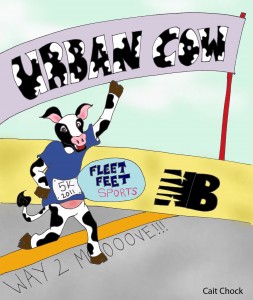Do you have any superstitions? Any little routines that you like have to do before a race? Some little secret good luck charms or habits that for whatever reason you do; you probably know on some level they are ‘dumb’ or silly and don’t reeaaally promise a good outcome, but you do it anyways…better safe than sorry, right? 😉

To a degree getting into a routine is a good thing:
* Keeps you organized
* Makes sure you don’t forget something
* Consistency is generally always the best bet in terms of running/workout performance (limit the variables)
So it could be argued that those little pre-race, or workout, ritual/routines DO have some kind of positive effect on the outcome. It’s more just a matter of what they are and how quirky they get. Hey, we all have embarrassing little habits/secrets, I’ll show you mine if you show me yours! 😉
Good ‘Normal’ Pre-race/run rituals:
* Starting your warm-up exactly the same time, every time out: this could be for both hard workouts and races…again, consistency
* Doing the same sequence of warm-up drills/strides: after your easy running, do your stretches, drills, and strides in the same order…helps your body know what’s coming and ensures you don’t forget something
* Putting the shoes/bib number/singlet on in the ‘right’ order: okay, here is kind of where we move towards not that important, but if it helps you not forget something…I know some people have to put such-and-such on at just the ‘right’, specific time before they go to the line
* Same pre-run/race foods: okay, the night before you probably want to steer clear of the World’s Hottest Tri-Bean Chili, but the night before isn’t going to make or break you (unless you’re moving into the marathon, plus races) but rather what you eat in the hours leading up to the run or race. Though, I won’t judge if you’ve ‘got’ to have your ritualistic bowl of pasta. You don’t need to feel chained to the SAME pre-run foods but it’s probably a good idea NOT to trying something new on race day.
The Funky Stupidstitions Superstitions:
* Lucky Charms: Okay, I’m not making fun of anyone who has them, because I used to like to race in a certain brand of socks…don’t worry I washed them and cycled through different pairs. (They had funny cartoons on them) Yes, I looked dorky, but I will say though, that going with comfort and socks I knew didn’t give me blisters isn’t totally invalid reasoning…maybe…hehe.
* Last Minute Details: I’ve known people who HAVE to eat exactly THREE pieces of a particular candy snack just before they put their spikes on…there was a girl who liked to listen to the exact same pump-up song during her warm-up…I liked to do one last jump in the air (I probably only cleared about 2 inches) just before the gun went off. These things don’t really impact the outcome, we know that, but it makes us feel secure…mmmmk.
* The Carry-ons: These guys are the ‘lucky’ things hidden away where only you know about them. Think the girl with the stuffed teddy crammed in her sweat bag. It could also be a bracelet or piece of jewelry I guess…these are kind of lucky charms but they have a little more meaning behind them. Maybe that stuffed teddy was given to her by Joan Benoit…you never know???
The thing is, routines and rituals are pretty normal in our sport. Runners do have to have a little bit of OCD in us to get our butts out the door to do the exact same motion day in and out. It’s just a matter of keeping routines in check so that they aren’t on the overly-obsessive side. An example is refusing to adjust your training regardless of how you’re feeling because you feel you HAVE to do XX number of miles/minutes.
That is not going to help you; in training you want to think of the program as the outline…as you go along you define the outline and that could include some erasing and reworking within reason. The same things goes for races, sometimes you have to think on the fly and adjust your pre-race plan. Be flexible…at least just a bit. 😉
1) Do you have any rituals that you like to do? Can be pre-race/run or anything else.
2) Do you generally like things scheduled and organized or are you a more on the fly person?
Depends on what it is I guess…with running and workouts I like a little more order.
3) And superstitions that you know logically have no bearing on the result but you like (or in the past liked) to do?























